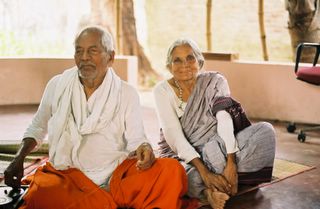Kuthur
I was awakened this morning at 4:45 a.m. by the most aw(e)ful music blaring over loudspeakers seemingly aimed at us from over the compound wall. Tsunami or no tsunami, this is pilgrimage season, and this total cacophony of sound – trumpets (actually a traditional instrument called a shennai), drums, penetrating piercing voices that drown out crows and human conversation – are in fact pilgrim hymns. On the roads around here, the pilgrims – mostly young males – wearing orange dhotis and with foreheads smeared with sandal paste – are traversing the 150 or so kilometers to the temple at Palani. Many of them will travel the entire distance on foot. Others will board small buses chartered for this purpose. Occasionally one finds a blue or black dhoti with silver trim – these pilgrims are headed to the Ayyappa temple more than 450 kilometers away in Kerala.
Kuthur is 12 kilometers from the coast, and is the heartbeat of Amma’s operations. Perhaps 5 acres in size, there is a hostel for poor and orphaned girls, a small outdoor meeting hall, various tractors and trucks, bicycles, a “canteen” (simply a large thatch-covered hut with blue tarps spread out on the ground), a cooking house that seemingly produces endless amounts of food, a small guest house that has been commandeered for Aliyah and me and our Italian friends, chickens, goats, and a few cows (and cowsheds), and a building that I have taken to calling “Krishnammal’s Kremlin”. Finished in pale pink plaster, with red trim, odd, windowed turrets and on each side, real sliding windows and glass door, the two-story structure is graced with palm fronds in front, and betrays an almost-modern sensibility. Appa wanted a structure more in keeping with LAFTI’s rural commitments (it is after all “Land for the Tillers’ Freedom”), and refuses to work inside. But the workers themselves, almost all from the lowest segment of society, wanted a structure that was forward-looking, something that the poor would see as worthy of their own interests.
The building was mostly paid for by the European Union and LAFTI’s Italian supporters, who are now myriad. In fact, Krishnammal has now undertaken to learn Italian, and carries a tape recorder in her purse with Italian language tapes. We jest that Aliyah was learning Italian at Smith in order to come to India, and will have to return this summer, and they can study together.
The building is humming with activity. There is an office for an EU development organization, all of LAFTI’s various projects, two large bathrooms with showers, a guest space for big-time dignitaries (we are family, and don’t count), and several large, empty rooms, as well as a flat roof.
Encamped here currently are relief teams from Gandhian organizations in Orissa, Maharastra, and Bombay, reporters from Bangalore, a yoga teacher, and various others. There are doctors and social workers and students among them, most in their late 20s and early 30s, some with experience working in earthquake disaster relief in far western India some years back. They are delighted to meet Aliyah and me, and I them. There are young Gandhians! We share many acquaintances in common, though it feels odd now to be an elder statesman, having been in their position (though American of course) some 25 or so years ago. Over dinner, each offers a prayer from their own particular tradition, and then ask me for mine. I note that I am a Quaker, and we usually use a silent grace, but stating that my own belief system is virtually the same as Amma’s, I chant a prayer in Tamil:
“Boundless benevolent shining light
God in-dwelling in that shining light
The light of compassion coming to rule the world.
That, combined with my rather minimal Tamil (they speaking none at all), identifies the two of us as being from among their own tribe, simply from a more distant province.
They all want to speak with us, especially those from Orissa, a rather remote place where there are few western visitors (but I HAVE been there, and know all their elders, including some now deceased, which especially pleases them). They almost never get to use their English, but it had a workout yesterday, especially in their provision of medical services through multiple translators.
Krishnammal wisely has us leave very early to tour more villages. She is afraid that they will all end up in endless conversations rather than getting out to do the necessary work, and Aliyah and I are among the temptations.
Once in the car, she begins to tell us about her ongoing partnership, as she describes it, with the Divine. “When I do this work,” she says, “I understand that we have an agreement. I supply myself as the vessel from which compassion can flow. But the Divine has to supply the tools. Sometimes when we are down to our last rupee, and I do not know where to turn, I simply stretch out my hand (in my mind),” she stretches us out her arm, “and it is provided for.” Her staff laugh, and nod. “It is not a miracle,” she notes, “and I am not a miracle worker.” “Yes,” I agree, we having had this conversation before, “Nothing is left to chance. It is simply a matter of fitting in with The Plan – even when we don’t know what The Plan is, exactly.”
We joke further about the achayapatra, the mythical vessel possessed by the Tamil saint Manimegalai, daughter of a prostitute, that allows her to reach inside and provide for the poor in their hour of need. Krishnammal points to the little pouch that she has around her neck, tucked into her bodice. “This is my achayapatra,” she indicates, “and when it is running low, it seems to replenish itself.” She is a master macro-economist, and leaves the banking end to someone else.


0 Comments:
Post a Comment
<< Home